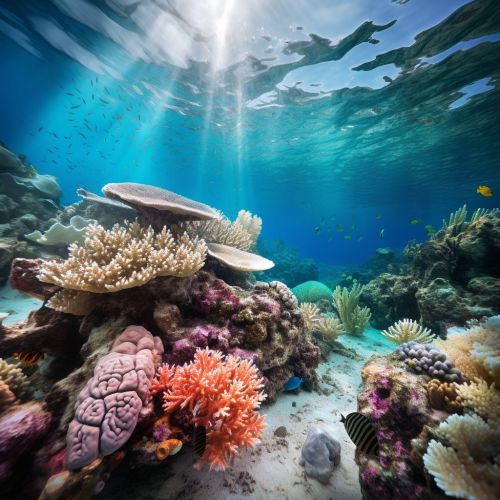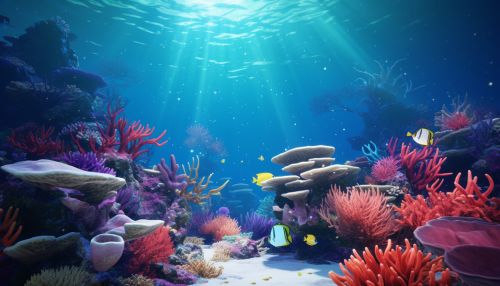The Science of Coral Bleaching and Climate Change
Introduction
Coral bleaching is a phenomenon that has been increasingly observed in the world's oceans over the past few decades. It is a direct response to changes in environmental conditions, particularly those related to climate change. This article will delve into the science behind coral bleaching, its relationship with climate change, and the implications for marine ecosystems and human societies.


Coral Biology and Symbiosis
Corals are marine invertebrates that belong to the phylum Cnidaria, which also includes sea anemones and jellyfish. They are colonial organisms, meaning they live in large groups, or colonies, composed of individual polyps. Each polyp is a small, soft-bodied organism that is attached to a hard, limestone skeleton, which it secretes.
A key aspect of coral biology is their symbiotic relationship with a type of algae known as zooxanthellae. These algae live within the coral polyps' tissues and provide the coral with nutrients through photosynthesis. In return, the coral provides the algae with a protected environment and access to light, which is necessary for photosynthesis. This symbiotic relationship is crucial for the survival of both the coral and the zooxanthellae, and it is what gives coral reefs their vibrant colors.
The Process of Coral Bleaching
Coral bleaching occurs when corals expel the symbiotic zooxanthellae living within their tissues. This results in the coral losing its color, hence the term 'bleaching'. The loss of zooxanthellae also means that the coral loses its main source of nutrients, making it more susceptible to disease and death.
The expulsion of zooxanthellae is a stress response triggered by changes in environmental conditions. The most common cause of coral bleaching is elevated sea temperatures, but other stressors can include changes in light conditions, reduced salinity due to heavy rainfall, and pollution.
Climate Change and Coral Bleaching
Climate change is a significant driver of coral bleaching events. The increase in greenhouse gas emissions, primarily carbon dioxide (CO2), leads to global warming, which in turn leads to an increase in sea surface temperatures. When sea temperatures rise above a certain threshold, it can cause the symbiotic zooxanthellae to produce an excess of oxygen radicals, which are harmful to the coral. This results in the coral expelling the zooxanthellae, leading to bleaching.
In addition to warming seas, climate change also leads to ocean acidification. This occurs when the oceans absorb excess CO2 from the atmosphere, which reacts with seawater to form carbonic acid. This increases the acidity of the ocean, making it more difficult for corals to build their calcium carbonate skeletons. This can weaken existing corals and make it more difficult for new ones to grow, further exacerbating the impacts of coral bleaching.
Impacts of Coral Bleaching
The impacts of coral bleaching are far-reaching and can have devastating effects on marine ecosystems and human societies. Coral reefs are often referred to as the 'rainforests of the sea' due to their high biodiversity. They provide habitat and food for a wide range of marine species, and their loss can lead to a decline in marine biodiversity.
Coral reefs also provide a number of ecosystem services that are crucial for human societies. These include coastal protection, as the physical structure of coral reefs helps to reduce the impact of waves and storms, preventing coastal erosion and protecting coastal communities. Coral reefs also support local economies through tourism and fisheries. The loss of coral reefs due to bleaching can therefore have significant socio-economic impacts.
Mitigation and Adaptation Strategies
Given the significant impacts of coral bleaching, it is crucial to develop and implement strategies to mitigate its effects and help coral reefs adapt to changing conditions. These strategies can be broadly divided into two categories: reducing the stressors that cause bleaching, and enhancing the resilience of coral reefs.
Reducing the stressors that cause bleaching primarily involves addressing climate change. This can be achieved through reducing greenhouse gas emissions, transitioning to renewable energy sources, and implementing carbon capture and storage technologies.
Enhancing the resilience of coral reefs can involve a range of strategies, including protecting existing healthy reefs, restoring degraded reefs, and developing and implementing coral breeding and transplantation programs. It can also involve research into coral genetics to identify and breed corals that are more resistant to bleaching.
Conclusion
Coral bleaching is a complex and multifaceted issue that is intrinsically linked to climate change. It poses a significant threat to marine ecosystems and human societies, but there are strategies that can be implemented to mitigate its impacts and help coral reefs adapt to changing conditions. Continued research and action in this area is crucial to ensure the survival of coral reefs and the myriad species that depend on them.
